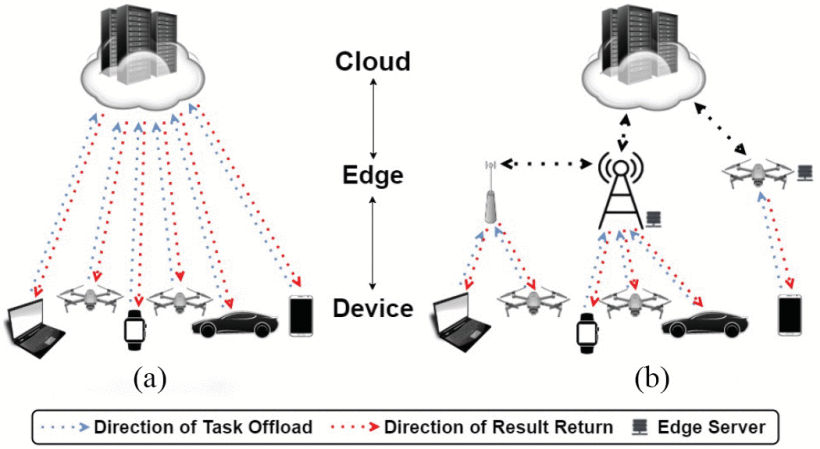A Survey on the Convergence of Edge Computing and AI for UAVs: Opportunities and Challenges
Unmanned Aerial Vehicles (UAVs), commonly known as drones, have many challenges and applications that can be improved with artificial intelligence (AI), edge computing, and edge AI.
AI "describes the work processes of machines that would require intelligence if performed by humans." Recently, robots/UAVs have used AI to achieve various intellectual tasks. Relative to traditional cloud computing, edge computing brings computing services (e.g., storage and processing) closer to end-users at the network edge. Rather than computation happening at distant cloud servers, the computation can happen at nearby edge servers, on devices (e.g., UAV/UAVs), or a combination of both. Edge AI can be summarized as the fusion of AI and edge computing.
Critical technical challenges of UAVs are autonomous navigation, power management, security and privacy, formation control, computer vision, and communication. Autonomous navigation can be further divided into localization and mapping, path planning, and collision avoidance systems. Important UAV applications include delivery systems, precision agriculture, civil infrastructure inspection, search and rescue operations, used as aerial wireless base stations, and drone light shows.
Traditional cloud AI, where computation happens at cloud servers, offers more processing power and storage space relative to edge AI. But edge AI has many advantages over cloud AI. Of particular note are lower latency, higher reliability, improved security and privacy, reduced cost, and reduced energy consumption.
The identified UAV technical challenges have certain edge AI benefits that are particularly important. For example, autonomous navigation (especially collision avoidance systems) relies significantly on edge AI’s lower latency. Given the speed at which UAVs travel, there is a high probability of a crash if detecting and avoiding obstacles is not done in fractions of a second. The improved latency offered by edge AI relative to cloud AI may be the difference between a crash and no crash. Different applications also have more reliance on particular technical challenges. For example, precision agriculture (e.g., crop management) relies mainly on the technical challenge of computer vision.
While the benefit of edge AI to UAVs and their technical challenges/applications is indisputable, there are numerous challenges when implementing edge AI for UAVs. Key edge AI implementation challenges for UAVs include developing distributed training algorithms, security and privacy, resource allocation, and real-time requirements. However, possible solutions to each implementation challenge can be identified. For example, the implementation challenge 'real-time requirements' outlines that UAVs frequently need feedback to be `real-time' (e.g., when tracking fast-moving cars).
But sometimes, gathering data, training models, and deciding on actions can take too long. One solution is to reduce inference time through 'model pruning' and 'knowledge distillation.' The future research directions of edge AI applied to UAVs can also be defined through the challenges faced and lessons learned.
UAVs and edge AI are exciting and active areas of research. There is much overlap between the two areas; hopefully, this paper can be a valuable resource for those interested in this overlap.




